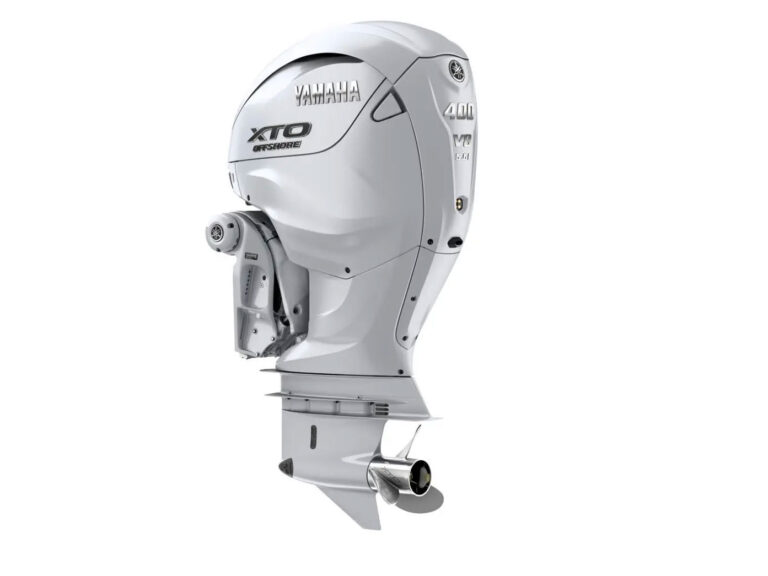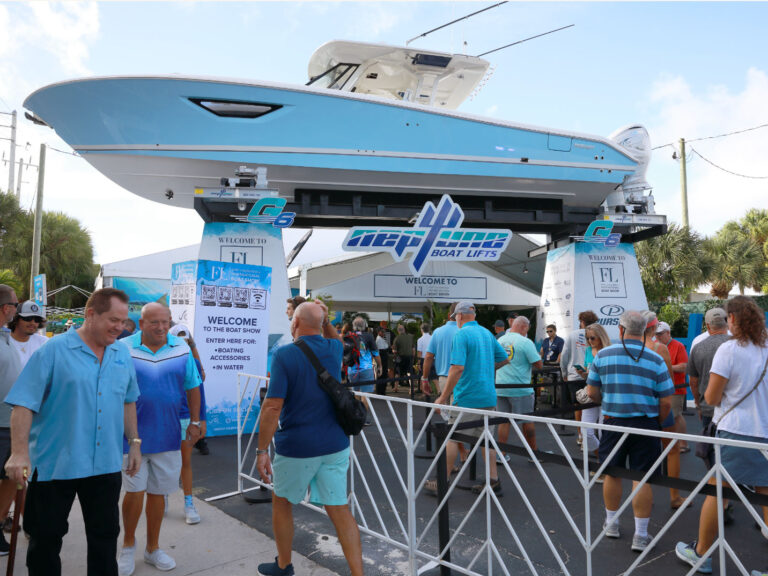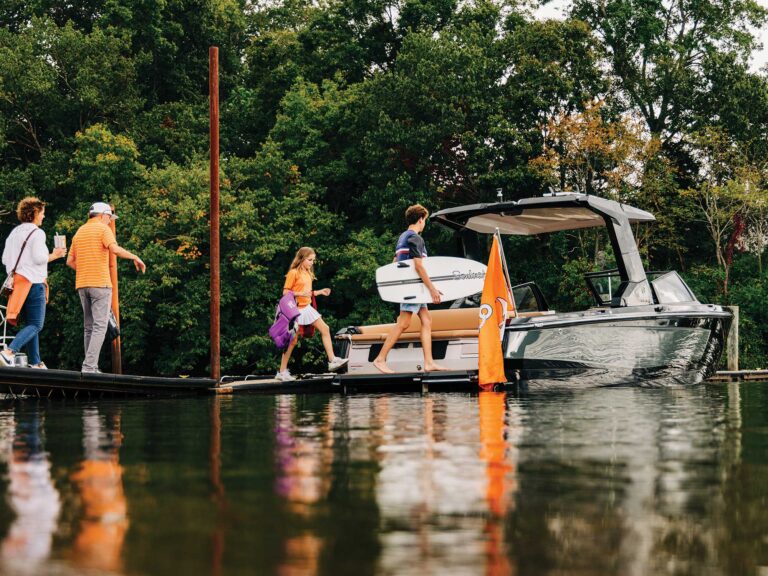A handheld, digital selective calling (DSC), very high frequency (VHF) radio is a convenient communication device and an essential emergency rescue tool. When registered with the Federal Communications Commission and programmed with your assigned Maritime Mobile Service Identity code (MMSI), it is capable of transmitting its own internally generated GPS position with an emergency signal that enables faster rescue by allowing one-button communication of your description and location to rescue services.
In our book, the ideal radio has to offer long battery life, clear audio qualities and easy GPS linkup, and it must be waterproof and float. (If only cellphones were made that way!)
How We Tested: Our test regimen mixed hard data with subjective opinion, tempered by The BoatingLAB team’s collective decades of experience using handheld marine VHF radios.
GPS Lock Time: The first GPS link always takes the longest, so we timed and averaged the second and third linkups after shutting each radio off between trials.
Battery Life: We used time-lapse video to time the battery life of each radio, left on without transmitting. Battery life specifications include manufacturers’ estimates of power drain with normal transmission intervals.
Transmit/Receive Clarity/Decibels: We judged transmit- and receive-quality subjectively. Two testers agreed on the results and in-the-field experiences with others on the Boating team supported the testing results. Our control radio, a Standard Horizon HX760S, was used to listen to transmissions from the test radios and to transmit to the test radios at approximately three-quarters of a mile.
Volume/Clarity/Decibels: With each test radio set to full volume, we measured the decibels (dB) of transmissions received. In an emergency, people may be screaming, the wind may be howling, or the seas may be roaring.
Float Test: Yep, we unceremoniously dumped them into an aquarium and left them there for a half-hour. They all passed.
Test Legend GPS Lock Time: Measured in seconds
Battery Life (hours:minutes): GPS was left on with no transmission time.
Test 1: Decibels of message received on control radio, set at midvolume with test radio transmitting at 5 watts
Test 2: Clarity of message received on control radio, set at midvolume with test radio transmitting at 5 watts
Test 3: Decibels of message received on test radio, set at full volume with control radio transmitting at 5 watts
Test 4: Clarity of message received on test radio, set at full volume with control radio transmitting at 5 watts
Test 5: Decibels of message received on test radio, set at full volume with control radio transmitting at 1 watt
Test 6: Clarity of message received on test radio, set at full volume with control radio transmitting at 1 watt
The more blue in the circle, the better the score.
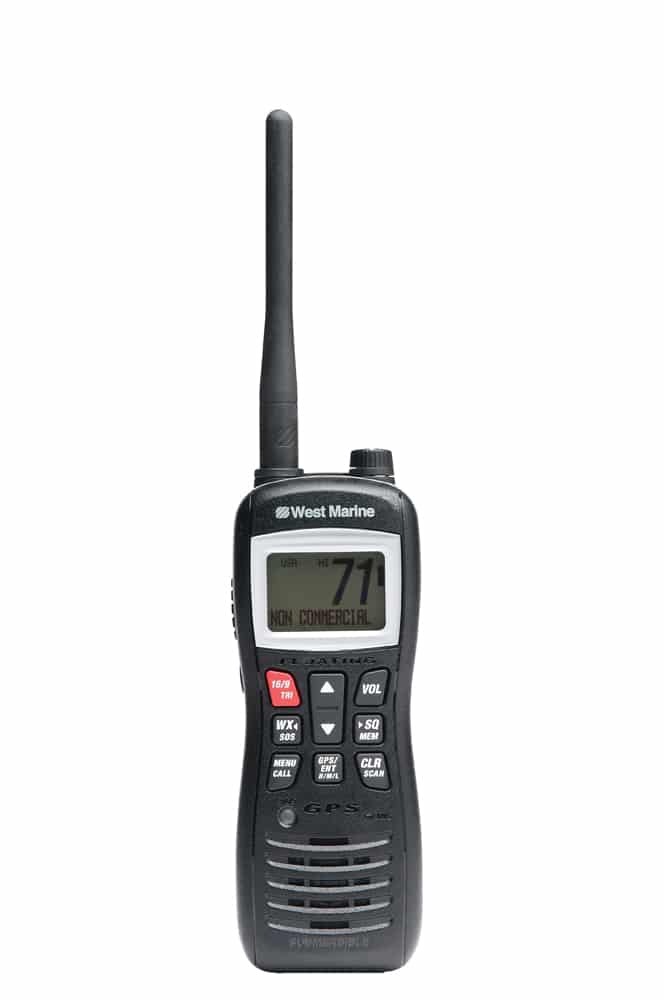
Westmarine VHF460
Price: $249.99
Warranty: Three years
A 6-watt power-boost transmission key maximizes clarity, and an SOS strobe light activates on command or upon accidental immersion, assisting in recovery should the radio be dropped. The GPS function stores 100 waypoints, and an external, corded microphone adds utility. Its luminous case gasket makes it easy to find in the dark. A narrow horizontal charger adapter saves space on the power strip.
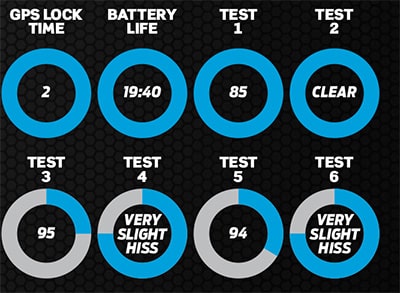
Features
Number of GPS Channels: 12 Screen Size: 1.5″ x 1″ Weight: 11 ounces (per mail scale — no spec available) Dimensions: 2.44″ x 6.29″ x 1.61″ Low to High Watts: 1, 2.5, 6 watts Li-Ion Power: Yes Alkaline Power: 4 AAA Channel Scan: Custom dual- and tri-channel Charger Base: Yes 12-Volt Charger: Yes Tactile Controls: On/Off, 16/9, Channel Up/Down
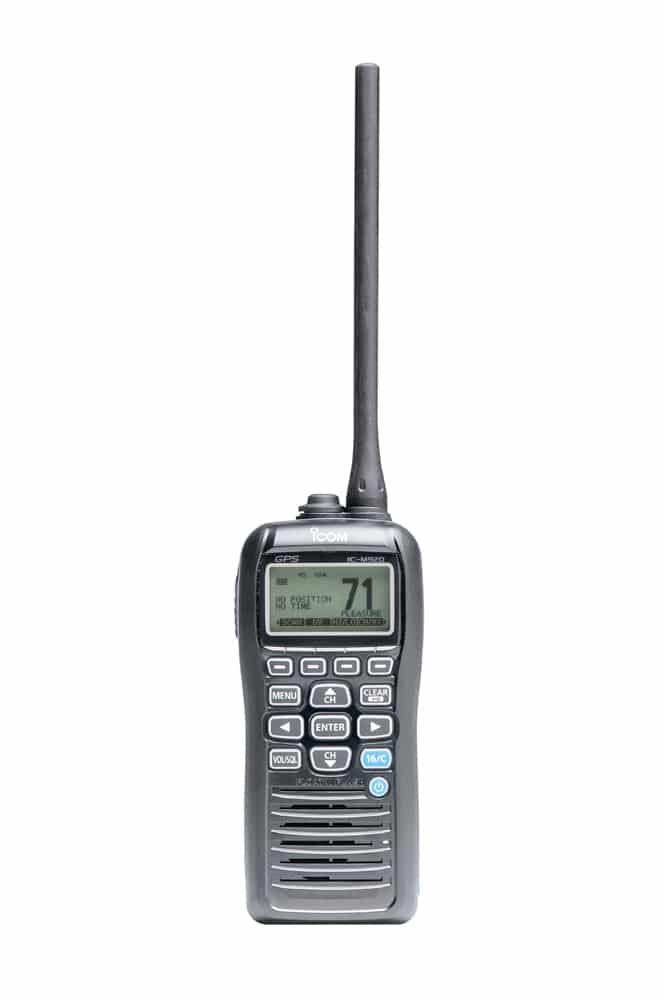
Icom IC-M92D
Price: $300
Warranty: Three years
The waterproof M92D has a noise-canceling mic that’s worked for us from the open door of a chopper during photo shoots. If the radio is dropped in the water, it activates a flashing LED to help relocate it. A low-frequency “buzz” that Icom calls AquaQuake purges water from the speaker face on command. An on-screen, soft-key directory minimizes the hassle of navigating among functions.
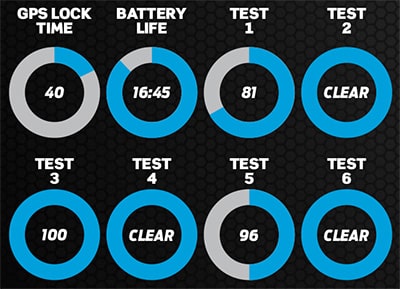
Features
Number of GPS Channels: 48 Screen Size: 1.625″ x 0.875″ Weight: 10.1 ounces Dimensions: 2.4″ x 5.6″ x 1.7″ Low to High Watts: 1, 5 watts Li-Ion Power: Yes Alkaline Power: No Channel Scan: Dual- or tri-channel Charger Base: Yes 12-Volt Charger: Yes Tactile Controls: On/Off, 16/9, Channel Up/Down
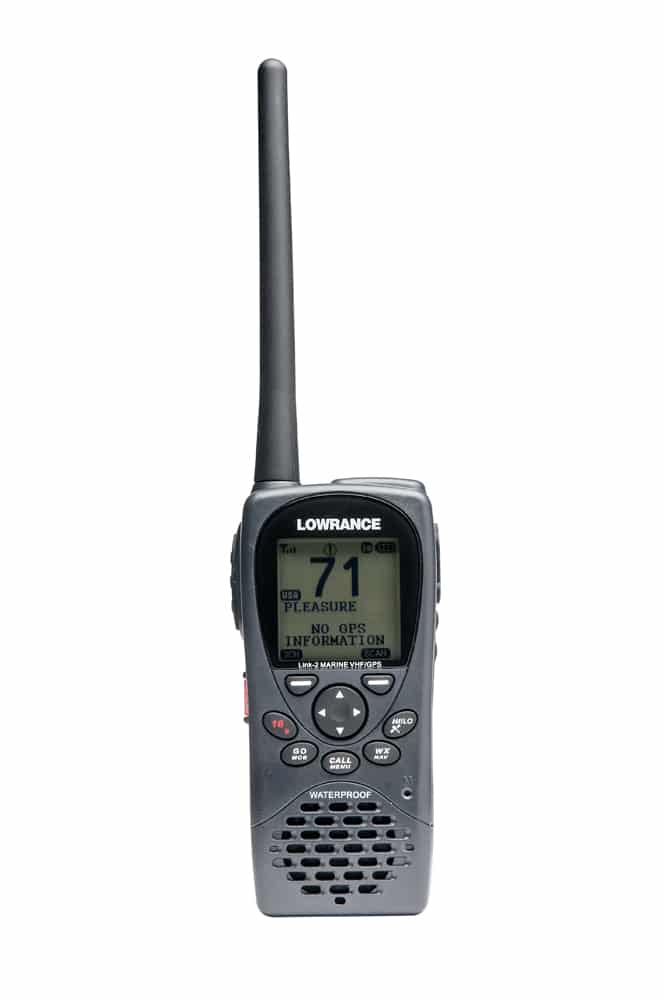
Lowrance Link-2
Price: $199
Warranty: Two years
This DSC radio has a GPS-linked man overboard function. The “Get Buddy” function allows other Link-2 holding buddies to receive or send position, bearing and distance at a button push. It stores up to 300 waypoints and 20 “buddy” DSC IDs. It sports the largest screen, and the most used controls are tactile.
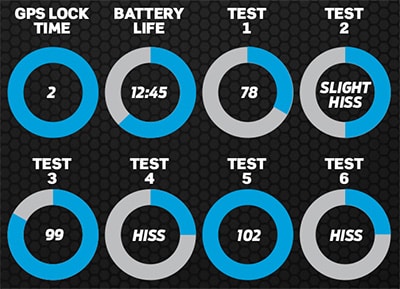
Features
Number of GPS Channels: 12 Screen Size: 1.5″ x 1.5″ Weight: 10.1 ounces Dimensions: 2.67″ x 5.5″ x 1.52″ Low to High Watts: 1, 5 watts Li-Ion Power: Yes Alkaline Power: No Channel Scan: Tri-channel Charger Base: Yes 12-Volt Charger: No Tactile Controls: On/Off, Volume, Squelch, 16/9, Channel Up/Down
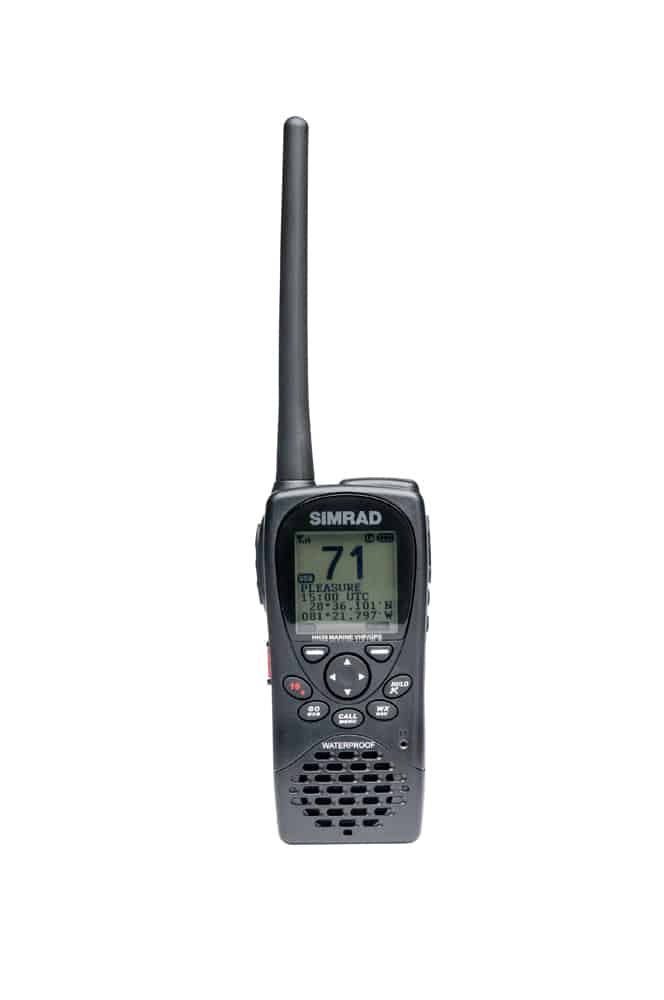
Simrad HH36
Price: $249.99
Warranty: Two years
Plotter mode displays waypoints and bearing. Like its Lowrance relative, it has the Get Buddy feature and the capability to store 300 waypoints and 20 “buddy” IDs. Dedicated MOB function means instant rescue positioning and, if coupled with another “Get Buddy” equipped radio, easy relocation and recovery. The most used controls are tactile.
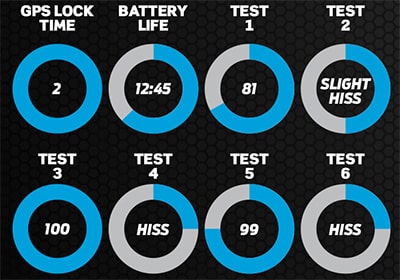
Features
Number of GPS Channels: 12 Screen Size: 1.5″ x 0.5″ Weight: 10.1 ounces Dimensions: 2.67″ x 5.5″ x 1.52″ Low to High Watts: 1, 5 watts Li-Ion Power: Yes Alkaline Power: No Channel Scan: Tri-channel Charger Base: Yes 12-Volt Charger: No Tactile Controls: On/Off, Volume, Squelch, 16/9, Channel Up/Down
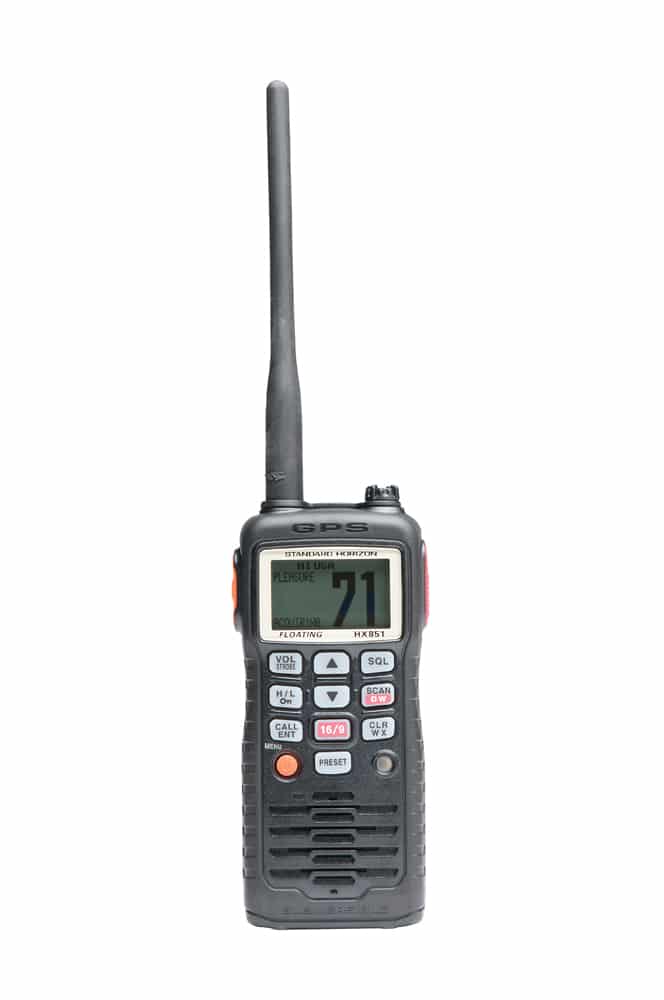
Standard Horizon HX851
Price: $249.99
Warranty: Three years
It stores up to 200 waypoints. The HX851 also transmits a “navigate to position” request to other radios via DSC. User-programmable channels. The SOS strobe is a good safety feature and doubles as a flashlight. It boasts a luminous housing gasket that assists in locating it in the dark.
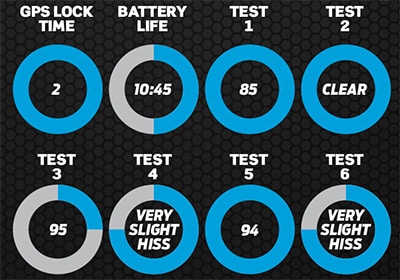
Features
Number of GPS Channels: 12 Screen Size: 1.6″ x 0.9″ Weight: 11.8 ounces Dimensions: 2.46″ x 5.57″ x 1.77″ Low to High Watts: 1, 2.5, 5, 6 watts Li-Ion Power: Yes Alkaline Power: 5 AAA Channel Scan: Preset 10 favorites Charger Base: Yes 12-Volt Charger: Yes Tactile Controls: On/Off, 16/9, Channel Up/Down
Notable Specs and Their Meaning to You
These radios offer boatloads of features. Here are some.
- Price: Bucks rule, but so do features.
- Warranty: The longer, the better!
- Number of GPS Channels: More usually means a faster GPS link.
- Screen Size: The bigger, the better (to see you)!
- Weight: Ounces
- Dimensions: Inches
- Low to High Watts: Low-wattage transmission conserves battery power and doesn’t clutter the bandwidth at long range.
- Lithium-Ion Power: Amen to ending the hunt for AA batteries
- Alkaline Power: AA batteries can provide a nice backup in an emergency, however.
- Channel Scan: Ability to set favorite channels or scan the whole spectrum
- Charger Base: More important for use on large boats
- 12-Volt Charger: More important for use on small boats
- Tactile Controls: Soft keys minimize waterproof case penetrations, but menus should be clear and easy to navigate. We think channel selection should be a first-line function and volume and squelch should be near at hand as well.






